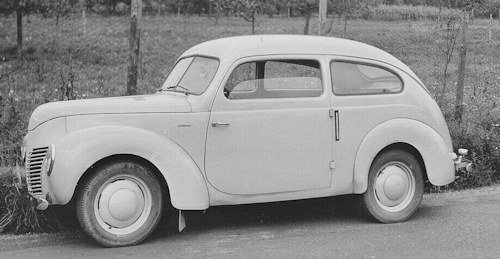Ford Taunus G93A G73A
 |
|
|
Production period: |
1939-1942 and 1948-1952 |
|
Class : |
Motor car |
|
Body versions : |
Saloon , station wagon ,convertible |
|
Engines: |
Gasoline : 1.2 liters (25 kW) |
|
Length: |
4080 mm |
|
Width: |
1485 mm |
|
Height: |
1600 mm |
|
Wheelbase : |
2387 mm |
|
Curb weight: |
840-1040 kg |
The Ford Taunus G93A was a car which the Ford works Cologne produced from 1939 to 1942 as a successor to the model Eifel .After the war in 1948 the model was reissued as Ford Taunus G73A and manufactured until 1952.
History
In 1938, Ford Cologne began designing a lower middle class car to be placed between the Ford Eifel and the Ford V8 . One chose a design in which the body is welded to the chassis . Stylistically, the new vehicle leaned against the American Lincoln Zephyr . Like the Eifel, the Taunus was equipped with solid axles and transverse leaf springs in the front and rear, but already had hydraulically operated brakes. Actually, the Taunus should get a 45 hp (33 kW) 1.5-liter engine, which was based on the side-steering 1.2-liter engine of the Eifel. The type restrictions of the Schell plan, which were introduced in March 1939 in anticipation of the war , allowed the German Ford plants but only a car between 1.2 and 2.0 liters of displacement. So it was ultimately in the known from the Eifel engine with 1172 cc and 34 hp (25 kW), which was combined with a three-speed gearbox with middle circuit; the Taunus came in May 1939 as a successor to the Eifel on the market.
The Taunus was made exclusively as a two-door sedan with rear-hinged doors . The bodies supplied Ambi-Budd in the east of Berlin ( Johannisthal ). Of the planned convertible, there was only one prototype. Until the war-related production set in February 1942, 7092 copies ran off the line.
After the Second World War , only the production of trucks was initially possible in the Cologne-Niehl plant. As early as 1946, the design of the prewar Taunus had been improved in detail. In May 1948, the new type was presented as Taunus G73A in Hanover at the 1948 export fair . The bodywork tools , which were at Ambi-Budd in East Berlin , could be triggered after long negotiations with the Soviet military administration . Lack of space allowed Ford from September 1948, the first Taunus bodies as wage work in Volkswagen Wolfsburg and Karmannfinished in Osnabrück. In November 1948, the entire production was relocated to Cologne. Furthermore, there was only a two-door sedan with rear-hinged doors in "Nachtschattengrau".
Other types of bodywork emerged in 1949 at the known body manufacturers such as Karmann in Osnabrück, Drauz in Heilbronn or Plasswilm in Cologne. Ford supplied the chassis with the front body up to the A-pillars. The body crew made two- and four-seater convertibles with two doors, four-door cabriolets (for the police), three-door station wagons and even four-door taxis.
From May 1950 there was the Taunus Spezial . The car has a four-speed gearbox with steering wheel circuitry, a wide, chrome grille, bumpers with horns, a larger rear window and turn signals instead of winkers . From January 1951, the Taunus de Luxe was built, with a continuous windscreen and many extras.
With a bore of 63.5 mm and a stroke of 92.5 mm, the 135 kg engine is designed with a long stroke and a compression ratio of 6.6: 1. The cast crankshaft (Ø 45 mm) has a triple bearing. Engine block and cylinder head are made of cast iron , the oil pan is cast from an aluminum alloy ( silumin ). The engine has standing valves . The camshaft is directly driven by a pair of spur gears (on the Novotex camshaft ) and driven by helical gearsthe vertical distributor shaft. The valve clearance can only be adjusted (increased) by grinding the valve stem ends. A V-belt drives the 6-volt DC alternator and the two-bladed radiator fan, there is no water pump ( thermosiphon cooling ).
The stated maximum power of 25 kW (34 hp) at 4250 rpm was sufficient for a top speed of 97.5 km / h, as a continuous power 22 kW (30 hp) at 3250 / min. The maximum torque of 72 Nm is at 2300 rpm. The life of the engine until the first overhaul was about 80,000 km.
The transmission has three gears. Only the second and third gears are synchronized . The cardan shaft runs in a tube and has only one universal joint behind the gearbox. To remove the gearbox, you have to remove the engine, or rather the rear axle.
The two axes are drawbar axes with transverse leaf springs, pushed forward and with a stabilizer called Panhard rod . There are double front and rear single-acting hydraulic shock absorbers. A special feature are the bearings of the rear wheels, in which the rollers run directly on the axle body. The service life of the axle is thus greatly reduced.
On all wheels, there are hydraulically operated Simplex - drum brakes . There is only one brake circuit . The handbrake acts on the rear wheels via cables .Every 1,500 km the oil had to be changed, every 4,500 km an inspection was due.From January 1952, the successor Taunus 12M was offered, but the production of the Buckeltaunus ran until the autumn of 1952. A total of 76,590 (74,128) copies of the Taunus G73A
The shape of his body with humpback tail . The name Taunus was used by Ford for other models until 1985, most recently in Argentina.
Manuals
-
Ford (europe) Previous 99 / 128 Next
